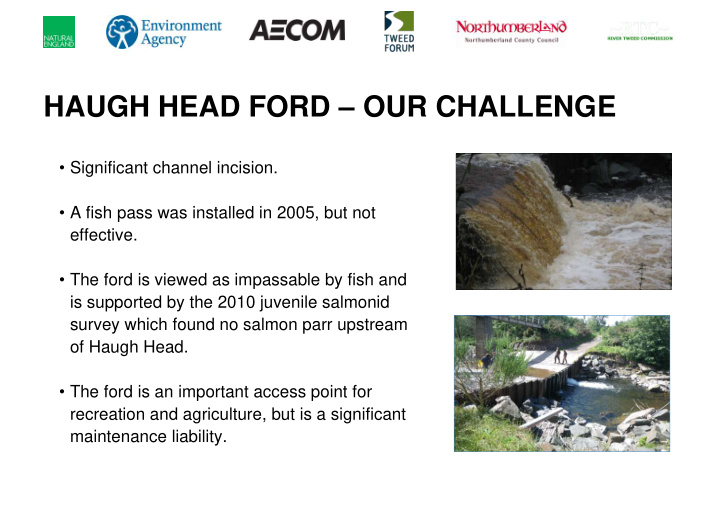



HAUGH HEAD FORD – OUR CHALLENGE • Significant channel incision. • A fish pass was installed in 2005, but not effective. • The ford is viewed as impassable by fish and is supported by the 2010 juvenile salmonid survey which found no salmon parr upstream of Haugh Head. • The ford is an important access point for recreation and agriculture, but is a significant maintenance liability.
Option 1 - Downstream Rock Ramp A rock ramp is a collection of large boulders grouped together to form a more natural gradient than the current conditions. Fish could move through the rock ramp by using a series of constructed pools. Several different variations of rock ramp may be possible, and some of the variations would include total removal of the ford. The length of the rock ramp would depend on the gradient that would be required in order to manage the water velocity. This option would provide improved fish passage and could maintain a crossing point at Haugh Head, however long-term maintenance would be required. It does not satisfy the environmental objectives of the project and an engineered structure would remain. Long profile of the regraded reaches for rock ramps for a: Option 1, b: Extended Option 1, and c: Option 2
Option 2 – Re-grading with a rock cascade Removal of the ford and check weirs. In- channel work to restore the channel gradient and to install a cascade of rocks. A rock cascade is an extended rock ramp. This option would provide fish passage and create a mixture of river conditions, restoring parts of the channel that have been adversely affected by the check weirs. A natural gravel ford would be created for pedestrians at the current location. Vehicle traffic would be diverted to Coldgate Mill. This option is the most expensive requiring a large volume of rock. Like Option 1, there would be a need for long- term maintenance and it does not satisfy the environmental objectives.
Option 3 - Ford removal with inset floodplain Removal of the ford and check weirs, and the creation of an inset floodplain (lowered sections of floodplain) to manage the velocity of water in the Wooler Water. The inset floodplain would connect existing floodplain areas upstream and downstream of the ford, allowing the river to use a wider area. The width of the floodplain at Haugh Head would be 60 – 100 metres. The existing footbridge would need to be removed. Installing a new footbridge would be expensive. This option would not require the intensive maintenance required for Options 1 and 2 and would satisfy environmental objectives and help reduce flood risk to nearby houses.
Retaining pedestrian and vehicle access We acknowledge the importance of the pedestrian and vehicle access for recreation, agricultural practice and community cohesion. Some of the options being considered mean the existing footbridge and solid ford structure will be removed. We are looking at a number of ways to mitigate the loss of access at Haugh Head. These include: formally rerouting the walking route to Coldgate Mill installation of stepping stones a gravel ford crossing investigating costs for a new footbridge, however significant additional contributions would be required to progress this option. Next actions We currently undertaking a site investigation to support an option improve the crossing at Coldgate Mill. We are also looking at the removal of the check-weirs upstream of the Ford.
Recommend
More recommend